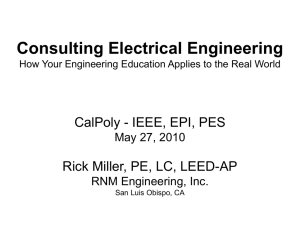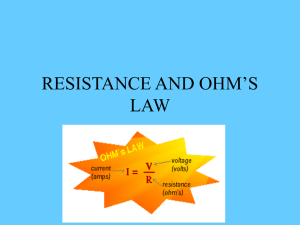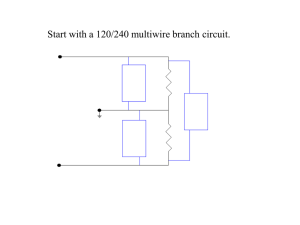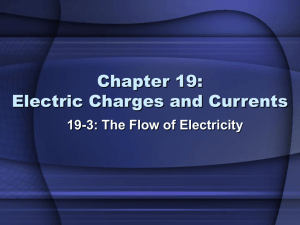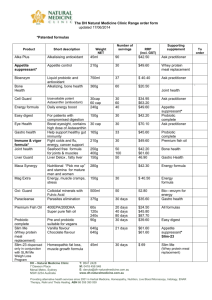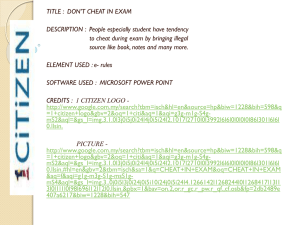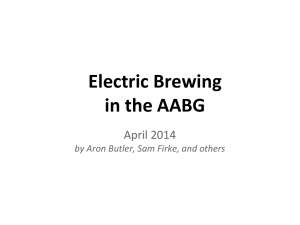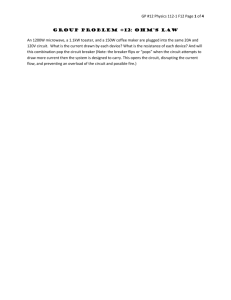WCT600 Spec
advertisement
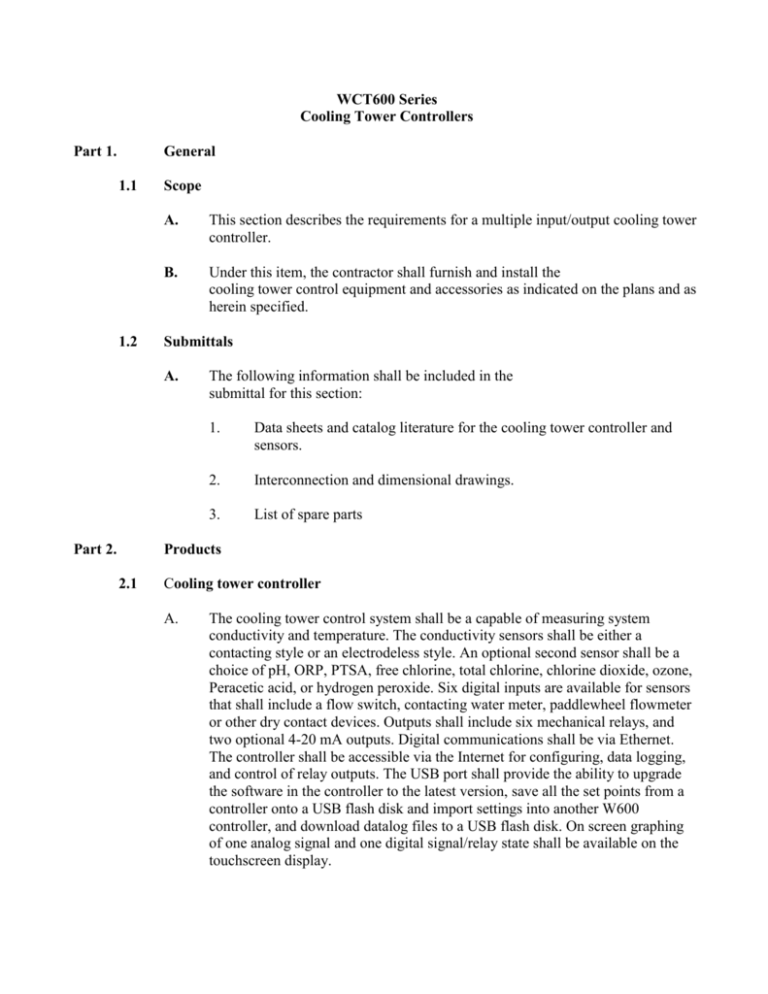
WCT600 Series Cooling Tower Controllers Part 1. General 1.1 1.2 Scope A. This section describes the requirements for a multiple input/output cooling tower controller. B. Under this item, the contractor shall furnish and install the cooling tower control equipment and accessories as indicated on the plans and as herein specified. Submittals A. Part 2. The following information shall be included in the submittal for this section: 1. Data sheets and catalog literature for the cooling tower controller and sensors. 2. Interconnection and dimensional drawings. 3. List of spare parts Products 2.1 Cooling tower controller A. The cooling tower control system shall be a capable of measuring system conductivity and temperature. The conductivity sensors shall be either a contacting style or an electrodeless style. An optional second sensor shall be a choice of pH, ORP, PTSA, free chlorine, total chlorine, chlorine dioxide, ozone, Peracetic acid, or hydrogen peroxide. Six digital inputs are available for sensors that shall include a flow switch, contacting water meter, paddlewheel flowmeter or other dry contact devices. Outputs shall include six mechanical relays, and two optional 4-20 mA outputs. Digital communications shall be via Ethernet. The controller shall be accessible via the Internet for configuring, data logging, and control of relay outputs. The USB port shall provide the ability to upgrade the software in the controller to the latest version, save all the set points from a controller onto a USB flash disk and import settings into another W600 controller, and download datalog files to a USB flash disk. On screen graphing of one analog signal and one digital signal/relay state shall be available on the touchscreen display. B. Control Module: 1. Enclosure: Polycarbonate Resin, NEMA 4X, lockable hinged door. 2. Power: 3. 100-240 VAC 10%, 50 or 60 Hz Inputs: Sensor Input Signals (0, 1 or 2 depending on model code) Contacting Conductivity 0.01, 0.1, 1.0, or 10.0 cell constant OR Electrodeless Conductivity OR Disinfection OR Requires a preamplified signal. Walchem WEL or WDS series Amplified pH or ORP recommended. ±5VDC power available for external preamps. Each sensor input card contains a temperature input Temperature 100 or 1000 ohm RTD, 10K or 100K Thermistor Analog (4-20 mA) Sensor Input (0, 2 or 4 depending on model code) 2-wire loop powered or self-powered transmitters supported 3 or 4 –wire transmitters supported Each sensor input board has two channels Channel 1, 130 ohm input resistance Channel 2, 280 ohm input resistance Available Power Two independent isolated 24 VDC ± 15% supplies per board 1.5 W maximum for each channel 2W (83 mA at 24 VDC) total power consumption for all channels (four total channels if two boards are installed; 2W is equivalent to 2 Little Dipper sensors) Digital Input Signals (6): State-Type Digital Inputs Electrical: Optically isolated and providing an electrically isolated 9V power with a nominal 2.3mA current when the digital input switch is closed Typical response time: < 2 seconds Devices supported: Any isolated dry contact (i.e. relay, reed switch) Types: Interlock Low Speed Counter-Type Electrical: Optically isolated and providing an electrically Digital Inputs isolated 9V power with a nominal 2.3mA current when the digital input switch is closed 0-10 Hz, 50 msec minimum width Devices supported: Any device with isolated open drain, open collector, transistor or reed switch Types: Contacting Flowmeter High Speed Counter-Type Electrical: Optically isolated and providing an electrically Digital Inputs isolated 9V power with a nominal 2.3mA current when the digital input switch is closed, 0-250 Hz, 1.25 msec minimum width Devices supported: Any device with isolated open drain, open collector, transistor or reed switch Types: Paddlewheel Flowmeter 4. Outputs: Powered mechanical relays (0 or 6 depending on model code): Pre-powered on circuit board switching line voltage 6 A (resistive), 1/8 HP (93 W) All six relays are fused together as one group, total current for this group must not exceed 6A Dry contact mechanical relays (0, 2 or4 depending on model code): 6 A (resistive), 1/8 HP (93 W) Dry contact relays are not fuse protected Pulse Outputs (0, 2 or4 depending on model code): Opto-isolated, Solid State Relay 200mA, 40 VDC Max. VLOWMAX = 0.05V @ 18 mA 4 - 20 mA (0 or 2) Internally powered Fully isolated 600 Ohm max resistive load Resolution 0.0015% of span Accuracy ± 0.5% of reading Ethernet 10/100 802.3-2005 Auto MDIX support Auto Negotiation 5. Software features: Six relay outputs may be set to a variety of control modes: On/Off set point control Time Proportional control Pulse Proportional Control (requires pulse output relay option) Dual set point Bleed or Feed based on a Water Contactor or Paddlewheel flow meter input Feed and Bleed Feed and Bleed with Lockout Feed as a percent of Bleed Feed as a percent of elapsed time Daily, Weekly, 2-week or 4-week Biocide timers with pre-bleed and post-add lockout of bleed Intermittent sampling for boilers with proportional blowdown, controlling on a trapped sample Always on unless interlocked Diagnostic Alarm Manual activation of the relays shall be easily accomplished via the keypad, or a PC. A maximum output on-time shall be available on the control relays to prevent runaway control. Any relay may be reconfigured to any one of a number of control algorithms, responding to the signal from any input desired. The optional analog inputs shall be configurable for fluorometers, level sensors, corrosion monitors, or any other type of transmitter, providing appropriate units of measure and scaling. The digital inputs shall be configurable for level switches, flowmeters, flow switches, or generic interlock operation. The optional analog outputs shall be configurable for retransmitting a sensor signal or for proportional control. The controller set points may be entered by downloading them from one controller, and uploading them into another controller. Access to the controller shall be possible using Ethernet, locally or via the Internet, or via the local touchscreen display, simultaneously if desired. No proprietary software shall be required on the user’s computer to communicate with the controller, or to view or change set points. C. Sensors: Contacting Conductivity 1. Operating principle: The conductivity sensor shall be driven with a low voltage AC signal, and the return signal voltage will vary with the conductivity of the intervening solution. The temperature sensor within this sensor compensates for the effect of temperature on the conductivity signal. 2. Materials of construction: Glass-Filled Polypropylene, Graphite or 316SS, FKM 3. Process connections: ¾” NPTF 4. Temperature range: 32-158 F, 0-70 C 5. Pressure range: 0-150 psi 6. Other materials and higher pressure sensors shall be made available. Electrodeless Conductivity 1. Operating principle: The conductivity sensor shall be driven with a low voltage AC signal, which induces a current in the surrounding liquid which varies in intensity with the conductivity of the liquid, which is picked up by the sensor and transmitted to the controller. The temperature sensor within this sensor compensates for the effect of temperature on the conductivity signal. 2. Materials of construction: CPVC, FKM 3. Process connections: ¾” NPTF 4. Temperature range: 32-158 F, 0-70 C 7. Pressure range: 0-150 psi pH 1. Operating principle: The pH sensor shall consist of a replaceable cartridge containing a pH sensitive glass and silver/silver chloride reference. Voltage signals from these shall be measured against the solution ground, and the differential voltage measurement sent to the 2. 3. 4. 5. 6. ORP 1. 2. 3. 4. 5. 6. control module. The temperature signal from the conductivity sensor shall be used to compensate the pH reading as well. Materials of construction: Glass-Filled Polypropylene, CPVC, HDPE, FKM, Glass Process connections: ¾” NPTF Temperature range: 50-158 F, 10-70 C Pressure range: 0-100 psi Other materials and higher pressure sensors shall be made available. Operating principle: The ORP sensor shall consist of a replaceable cartridge containing a platinum electrode and silver/silver chloride reference. Voltage signals from these shall be measured against the solution ground, and the differential voltage measurement sent to the control module. Materials of construction: Glass-Filled Polypropylene, CPVC, HDPE, FKM, Glass, and Platinum. Process connections: ¾” NPTF Temperature range: 32-158 F, 0-70 C Pressure range: 0-100 psi Other materials and higher pressure sensors shall be made available. DISINFECTION 1. Operating principle: The oxidizer molecules diffuse through the membrane and in the acidic environment of the electrolyte fill solution, a redox reaction occurs at the electrodes in the sensor. The current generated by this reaction is converted to a robust voltage signal that is linear with the concentration of the oxidizer. 2. Materials of construction: Glass-Filled Polypropylene, PVC, Silicone rubber, polycarbonate, 316SS, PEEK. 3. Process connections: ¾” NPTF 4. Temperature range: 41-113 F, 5-45 C (typical) 5. Pressure range: 0-14.7 psi (0-1 atmosphere) D. Controller and Sensor Performance 0.01 Cell Contacting Conductivity Range 0-300 µS/cm Resolution 0.01 µS/cm, 0.0001 mS/cm, 0.001 mS/m, 0.0001 S/m, 0.01 ppm Accuracy ± 1% of reading 0.1 Cell Contacting Conductivity Range 0-3,000 µS/cm Resolution 0.1 µS/cm, 0.0001 mS/cm, 0.01 mS/m, 0.0001 S/m, 0.1 ppm Accuracy ± 1% of reading 1.0 Cell Contacting Conductivity Range 0-30,000 µS/cm Resolution 1 µS/cm, 0.001 mS/cm, 0.1 mS/m, 0.0001 S/m, 1 ppm Accuracy ± 1% of reading 10.0 Cell Contacting Conductivity Range 0-300,000 µS/cm Resolution 10 µS/cm, 0.01 mS/cm, 1 mS/m, 0.001 S/m, 10 ppm Accuracy ± 1% of reading pH Range Resolution Accuracy -2 to 16 pH units 0.01 pH units ± 0.01% of reading ORP Range Resolution Accuracy -1500 to 1500 mV 0.1 mV ± 1 mV Disinfection Sensors Range (mV) -2000 to 1500 mV Resolution (mV) 0.1 mV Accuracy (mV) ± 1 mV Range (ppm) 0-2 ppm to 0-20,000 ppm Resolution (ppm) Varies with range and slope Accuracy (ppm) Varies with range and slope Temperature Range Resolution Accuracy Analog (4-20 mA) Range 0 to 22 mA Resolution 0.01 mA Accuracy ± 0.5% of reading 23 to 500°F (-5 to 260°C) 0.1°F (0.1°C) ± 1% of reading Electrodeless Conductivity Ranges 500-12,000 µS/cm 3,000-40,000 µS/cm 10,000-150,000 µS/cm 50,000-500,000 µS/cm 200,000-2,000,000 µS/cm E. Resolution 1 µS/cm, 0.01 mS/cm, 0.1 mS/m, 0.001 S/m, 1 ppm 1 µS/cm, 0.01 mS/cm, 0.1 mS/m, 0.001 S/m, 1 ppm 10 µS/cm, 0.1 mS/cm, 1 mS/m, 0.01 S/m, 10 ppm 10 µS/cm, 0.1 mS/cm, 1 mS/m, 0.01 S/m, 10 ppm 100 µS/cm, 0.1 mS/cm, 1 mS/m, 0.1 S/m, 100 ppm Accuracy ± 1% of reading ± 1% of reading ± 1% of reading ± 1% of reading ± 1% of reading Indication 1. Graphic User Interface A 320 x 240 pixel monochrome backlit display with touchscreen shall indicate the process values, the status of outputs and alarms, and provide for all settings and calibrations. Six LED lamps shall indicate the on/off status of the control outputs. F. Equipment The cooling tower controller shall be a Walchem WCT600 series. Part 3. Operator Functions 3.1 3.2 Part 4. Calibration A. The sensor calibration shall be a one point process calibration, a two point buffer calibration, or a one point buffer calibration. B. All set points shall be set through the touchscreen, or via a PC connected either locally or remotely via Ethernet. C. Two levels of access codes shall be available to protect all set points and calibrations, while allowing the user to view any set point. Control Module Function Details A. Each control output shall be able to be set to any of the available control modes listed above. B. The inhibitor chemical feed output shall be on/off control with four choices of feed modes. C. All control relays shall have limit timers to prevent runaway control. D. The biocide programs shall provide a conductivity-based or a time-based prebleed prior to the biocide addition, and a time-based lockout of the bleed after the biocide addition. E. The controller shall be able to interlock any relay output based on a digital input, or based on another specific relay being active. Execution 4.1 Installation A. The sensors shall be installed in a location where they will always remain immersed in the sample. A. The sensors shall be installed in a location where there is good solution movement and where they will respond rapidly to changes B. The sensor cables shall be routed such that they are separated from any AC voltage by at least 6 inches. Part 5. C. If the sensor cable needs to be extended beyond the standard length, then 24 AWG, 3 twisted pair, shielded cable shall be utilized. E. If the optional 4 – 20 mA output or water meter contactor are installed, then 22-26 AWG, twisted pair, shielded cable shall be utilized. F. The sample line shall be tapped from the discharge side of the cooling tower recirculation pump, and returned to either the cooling tower sump or the suction side of the recirculation pump. Warranty 5.1 Terms A. The manufacturer of the above specified equipment shall guarantee equipment of its manufacture, and bearing its identification to be free from defects in workmanship and material for a period of 24 months for electronics and 12 months for mechanical parts from date of delivery from the factory or authorized distributor under normal use and service and otherwise when such equipment is used in accordance with instructions furnished by the manufacturer and for the purposes disclosed in writing at the time of purchase, if any. B. In the event a component fails to perform as specified and having been returned to the manufacturer transportation charges prepaid, and is proven defective in service during the warranty period, the manufacturer shall repair or replace the defective part. Replaceable elastomeric parts and glass components are expendable and are not covered by any warranty. Part 6. Options 6.1 Related Equipment A. B. C. D. Part 7. Solenoid valve for bleed control Water meter for makeup and/or bleed flow Level switch or level transmitter for chemical level monitoring Metering pumps for chemical control Spare Parts 7.1 Recommended Spare Parts A. 102834 Fuse, F1, 6 amp 250 V, 5 x 20 mm Part 8. Dimensions Panel Dimensions W600-CT- A B Tolerances: BN/FN C D E F +/- 0.1", 2.5 mm 13" 330 mm 12" 305 mm 11.75" 298 mm 10.75" 273 mm BA/BB/BC/B 22.5" D/FA/FB/FC/ 571 mm FD 21.5" 546 mm 11.75" 298 mm 10.75" 273 mm G H +/- 0.3", 8 mm I J +/- 0.01", 0.25 mm +/- 0.3", 8 mm 0.5" 12.7 mm 7" 178 mm 2" 51 mm 1.5" 38 mm 0.25" 6.35 mm 0.5" 12.7 mm 4" 102 mm 1.5" 38 mm 11" 279 mm 0.25" 6.35 mm DN 22.5" 571 mm 21.5" 546 mm 11.75" 298 mm 10.75" 273 mm 0.5" 12.7 mm 7" 178 mm 7" 178 mm 10" 254 mm 0.25" 6.35 mm DE/DF 22.5" 571 mm 21.5" 546 mm 11.75" 298 mm 10.75" 273 mm 0.5" 12.7 mm 4" 102 mm 2" 51 mm 10" 254 mm 0.25" 6.35 mm HN 24" 610 mm 22.5" 571 mm 19" 483 mm 17.5" 445 mm 0.75" 19 mm 14" 356 mm 6" 152 mm 3" 76 mm 0.25" 6.35 mm HA 24" 610 mm 22.5" 571 mm 19" 483 mm 17.5" 445 mm 0.75" 19 mm 11" 279 mm 6" 152 mm 3" 76 mm 0.25" 6.35 mm Part 9. Wiring POWER SWITCH FUSE R1 R2 1 2 3 4 5 6 7 8 9 10 11 12 13 14 15 16 17 18 TB1 SENSOR LABEL 1 2 3 4 5 6 7 8 9 10 11 12 13 14 15 16 17 18 1 2 3 4 5 6 7 8 9 10 11 12 13 14 15 16 17 18 TB3 N N N N N N 1 2 3 4 5 6 7 8 9 10 11 12 13 14 15 16 17 18 R3 R4 R5 TB5 R6 TB4 TB7 TB6 TB2 TEMP– WHT TEMP+ GRN RCV BLACK SHIELD XMT RED TB1 or 2 Conductivity Electrode Contacting Conductivity Sensor Input Wiring POWER SWITCH FUSE R1 R2 1 2 3 4 5 6 7 8 9 10 11 12 13 14 15 16 17 18 TB1 SENSOR LABEL 1 2 3 4 5 6 7 8 9 10 11 12 13 14 15 16 17 18 1 2 3 4 5 6 7 8 9 10 11 12 13 14 15 16 17 18 TB3 N N N N N N 1 2 3 4 5 6 7 8 9 10 11 12 13 14 15 16 17 18 R3 R4 R5 TB5 R6 TB4 TB7 TB2 TEMP – TEMP + RCV – RCV + SHIELD XMT + XMT – TB1 or 2 Conductivity Electrode Electrodeless Conductivity Sensor Input Wiring TB6 POWER SWITCH FUSE R1 R2 1 2 3 4 5 6 7 8 9 10 11 12 13 14 15 16 17 18 TB1 1 2 3 4 5 6 7 8 9 10 11 12 13 14 15 16 17 18 N N N N N N 1 2 3 4 5 6 7 8 9 10 11 12 13 14 15 16 17 18 TB3 R3 R4 R5 TB5 R6 TB4 TB7 TB6 TB2 Optional Temperature Compensation SENSOR LABEL 1 2 3 4 5 6 7 8 9 10 11 12 13 14 15 16 17 18 TEMP– WHT/GRN TEMP+ GRN/WHT IN– WHT/ORN IN+ ORN/WHT SHIELD +5V BLU/WHT -5V WHT/BLU TB1 or 2 pH/ORP electrode pH/ORP Sensor Input Wiring POWER SWITCH FUSE R1 R2 1 2 3 4 5 6 7 8 9 10 11 12 13 14 15 16 17 18 TB1 SENSOR LABEL 1 2 3 4 5 6 7 8 9 10 11 12 13 14 15 16 17 18 IN– WHT IN+ GRN 1 2 3 4 5 6 7 8 9 10 11 12 13 14 15 16 17 18 TB3 N N N N N N 1 2 3 4 5 6 7 8 9 10 11 12 13 14 15 16 17 18 R4 R5 TB5 R6 TB4 TB2 SHIELD +5V R3 RED -5V BLK TB1 or 2 Disinfection Sensor Input Wiring TB7 TB6 POWER SWITCH FUSE R1 R2 1 2 3 4 5 6 7 8 9 10 11 12 13 14 15 16 17 18 TB1 TB Pin# 1 2 3 4 5 6 7 8 9 10 11 12 2 Wire Loop +24V XMTR– Type of Transmitter 2 Wire 3 Wire Powered +24V XMTR– XMTR+ SHIELD SHIELD +24V XMTR– XMTR– XMTR+ SHIELD SHIELD XMTR+ COM(-) SHIELD +24V XMTR+ COM(-) SHIELD 4 Wire AI# +24V 24V(–) XMTR– XMTR+ 1 SHIELD +24V 24V(–) XMTR– XMTR+ SHIELD 2 1 2 3 4 5 6 7 8 9 10 11 12 1 2 3 4 5 6 7 8 9 10 11 12 13 14 15 16 17 18 N N N N N N 1 2 3 4 5 6 7 8 9 10 11 12 13 14 15 16 17 18 TB3 R3 R4 R5 TB5 R6 TB4 TB7 TB6 TB2 RED Power LK nd B Grou N R – B RN + O Little Dipper POWERED 4-20mA SOURCE – • SIMULATOR + • POWERED 4-20mA OUTPUT ld Shie (i.e. W100) TB1 or 2 TB Pin# 1 2 3 4 5 6 7 8 9 10 11 12 2 Wire Loop +24V XMTR– Type of Transmitter 2 Wire 3 Wire Powered +24V XMTR– XMTR+ SHIELD SHIELD +24V XMTR– XMTR– XMTR+ SHIELD SHIELD XMTR+ COM(-) SHIELD +24V XMTR+ COM(-) SHIELD 4 Wire AI# +24V 24V(–) XMTR– XMTR+ 1 SHIELD +24V 24V(–) XMTR– XMTR+ SHIELD 2 UNPOWERED 1 2 3 4 5 6 7 8 9 10 11 12 + 2 WIRE TRANSMITTER Jumper wire – Shie ld 24V Po wer UNPOWERED Jumper wire + Signal – Ground Shield TB1 or 2 4-20mA Sensor Input Wiring 3 WIRE TRANSMITTER POWER SWITCH FUSE R1 R2 1 2 3 4 5 6 7 8 9 10 11 12 13 14 15 16 17 18 TB1 1 2 3 4 5 6 7 8 9 10 11 12 13 14 15 16 17 18 TB3 N N N N N N 1 2 3 4 5 6 7 8 9 10 11 12 13 14 15 16 17 18 R3 R4 R5 TB5 R6 TB4 TB7 TB6 TB2 SIGNAL IN – POWER +9V Hall Effect FLOW METER TB1, 2 OR 3 SAFETY COVER LABEL 1 2 3 4 5 6 7 8 9 10 11 12 13 14 15 16 17 18 (TB 3 SHOWN) Digital Input Wiring Reed Switch FLOW METER Polarity not Critical FLOW SWITCH Contact Closure: Polarity not critical POWER SWITCH FUSE R1 R2 1 2 3 4 5 6 7 8 9 10 11 12 13 14 15 16 17 18 TB1 TO TB4 WHT 120V BLU 240V GRN 120V GRN/YEL 240V TB3 N N N N N N 1 2 3 4 5 6 7 8 9 10 11 12 13 14 15 16 17 18 R3 R4 R5 TB5 R6 TB4 TB7 TB6 TB2 IF MOTORIZED BALL VALVE NO BLK 120V BRN 240V SOLENOID/ MOTORIZED BALL VALVE WHT 120V BLU 240V 1 2 3 4 5 6 7 8 9 10 11 12 13 14 15 16 17 18 NC NO NC BLK 120V BRN 240V NO WHT 120V BLU 240V GRN 120V GRN/YEL 240V WHT 120V BLU 240V BLK 120V BRN 240V TO TB4 NC NO BLK 120V BRN 240V NC NO BLK 120V BRN 240V TB5 PUMP NC NO NC TO TB4 WHT 120V BLU 240V GRN 120V GRN/YEL 240V GRN 120V GRN/YEL 240V TO TB4 R3 R4 R5 R6 WHT 120V BLU 240V BLK 120V BRN 240V TO TB4 ALARM Power Supply (115 VAC or 230 VAC) W600 AC Power & Relay Output Wiring R2 TB6 PUMP GRN 120V GRN/YEL 240V R1 TB7 POWER SWITCH FUSE R1 R2 1 2 3 4 5 6 7 8 9 10 11 12 13 14 15 16 17 18 TB1 1 2 3 4 5 6 7 8 9 10 11 12 13 14 15 16 17 18 TB3 1 2 3 4 5 6 7 8 9 10 11 12 13 14 15 16 17 18 R3 R4 TB5 R5 R6 TB4 TB7 TB2 TB6 If motorized ball valve GRN 120V GRN/YEL 240V R1 WHT 120V BLU 240V BLK 120V BRN 240V WHT 120V BLU 240V R2 BLK 120V BRN 240V TB5 GRN 120V GRN/YEL 240V R3 PLC Fused External Power Source Fused External Power Source GRN 120V GRN/YEL 240V TB4 GRN 120V GRN/YEL 240V WHT 120V BLU 240V BLK 120V BRN 240V R4 BLK 120V BRN 240V GRN 120V GRN/YEL 240V WHT 120V BLU 240V BLK 120V BRN 240V R5 ALARM R6 WHT 120V BLU 240V BLK 120V BRN 240V TB6 TB7 Power Supply (115 VAC or 230 VAC) W610 AC Power & Relay Output Wiring POWER SWITCH FUSE R1 R2 1 2 3 4 5 6 7 8 9 10 11 12 13 14 15 16 17 18 TB1 1 2 3 4 5 6 7 8 9 10 11 12 13 14 15 16 17 18 TB3 1 2 3 4 5 6 7 8 9 10 11 12 13 14 15 16 17 18 R3 R4 TB5 R5 R6 TB4 TB7 TB2 TB6 External AC Power R1 External AC Power R2 R3 PLC Fused External Power Source Fused External Power Source GRN 120V GRN/YEL 240V TB4 GRN 120V GRN/YEL 240V WHT 120V BLU 240V R4 BLK 120V BRN 240V GRN 120V GRN/YEL 240V WHT 120V BLU 240V BLK 120V BRN 240V R5 ALARM R6 WHT 120V BLU 240V BLK 120V BRN 240V TB6 TB7 Power Supply (115 VAC or 230 VAC) W620 AC Power & Relay Output Wiring POWER SWITCH FUSE R1 R2 1 2 3 4 5 6 7 8 9 10 11 12 13 14 15 16 17 18 1 2 3 4 5 6 7 8 9 10 11 12 13 14 15 16 17 18 TB3 TB1 1 2 3 4 5 6 7 8 9 10 11 12 13 14 15 16 17 18 R3 R4 TB5 R5 R6 TB4 TB7 TB2 TB6 External AC Power R1 External AC Power R2 External AC Power R3 External AC Power R4 R5 PLC GRN 120V GRN/YEL 240V TB4 Fused External Power Source WHT 120V BLU 240V BLK 120V BRN 240V GRN 120V GRN/YEL 240V WHT 120V BLU 240V BLK 120V BRN 240V R6 ALARM TB6 TB7 Power Supply (115 VAC or 230 VAC) W640 AC Power & Relay Output Wiring POWER SWITCH FUSE R1 R2 1 2 3 4 5 6 7 8 9 10 11 12 13 14 15 16 17 18 TB1 1 2 3 4 5 6 7 8 9 10 11 12 13 14 15 16 17 18 + – SHIELD Chart Recorder TB1 1 2 3 4 5 6 7 8 9 10 11 12 13 14 15 16 17 18 TB3 N N N N N N 1 2 3 4 5 6 7 8 9 10 11 12 13 14 15 16 17 18 Analog Output Wiring R4 R5 TB5 R6 TB4 TB7 TB6 TB2 1 2 3 4 5 6 7 8 9 10 11 12 13 14 15 16 17 18 SAFETY LABEL R3 + – SHIELD TB2 Chart Recorder
